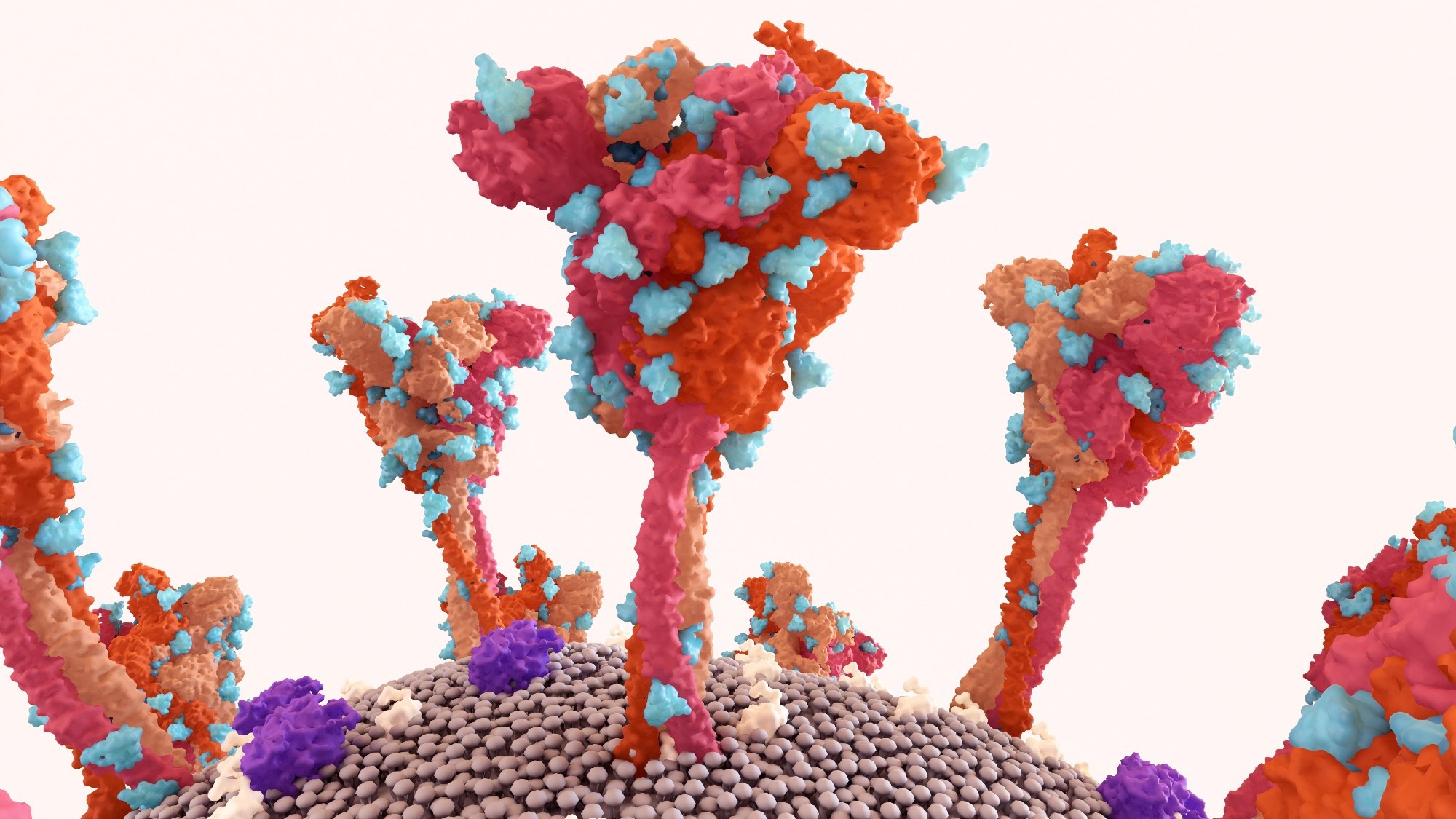A new study reveals how targeted electromagnetic waves can disrupt the SARS-CoV-2 spike protein, potentially opening doors to innovative disinfection and infection control strategies.
 Study: Electromagnetic waves destabilize the SARS-CoV-2 Spike protein and reduce SARS-CoV-2 Virus-Like particle (SC2-VLP) infectivity. Image Credit: Design_Cells / Shutterstock
Study: Electromagnetic waves destabilize the SARS-CoV-2 Spike protein and reduce SARS-CoV-2 Virus-Like particle (SC2-VLP) infectivity. Image Credit: Design_Cells / Shutterstock
Electromagnetic waves appear to alter the conformation of the Severe Acute Respiratory Syndrome Coronavirus 2 (SARS-CoV-2) Spike protein, non-thermally diminishing viral attachment and entry. A new Scientific Reports study adapted a coplanar waveguide (CPW) to detect frequencies capable of reducing the infectivity of SARS-CoV-2 virus-like particles (SC2-VLPs).
Reducing the Infectivity of SARS-CoV-2 Virus-Like Particles
Coronaviruses infect a wide variety of mammals and can potentially lead to mild or severe disease. In recent history, three human coronaviruses have emerged, namely, Middle East Respiratory Syndrome (MERS), Severe Acute Respiratory Syndrome Coronavirus 1 (SARS or SARS-CoV-1), and SARS-CoV-2. Given the observed infectivity of SARS-CoV-2 during the coronavirus disease 2019 (COVID-19) pandemic, strategies are needed to reduce infectivity and curb its transmission.
Standard pathogen neutralization includes utilizing ultraviolet and ionizing radiation, high temperatures, and chemical agents. An alternative strategy involves the use of electromagnetic waves, which possess uniform heating, high penetration, and minimal pollution. Critically, the study highlights non-thermal effects, such as altering Spike protein conformation, rather than heat- or physical destruction-based mechanisms.
About the Study
This study assessed whether a range of electromagnetic wave frequencies could reduce the infectivity of SARS-CoV-2’s virus-like particles in an experimental model. A system using SC2-VLPs was adapted to package and deliver exogenous RNA transcripts to specific target cells. Key aspects of SARS-CoV-2 are represented in SC2-VLPs, as they contain the structural proteins, i.e., Envelope, Membrane, Nucleocapsid, and Spike. In a Biosafety Level 2 (BSL2) setting, a CPW was employed to gauge the absorption spectrum of SC2-VLPs. A CPW is a waveguide in which the conductors that support wave propagation are placed on the same plane.
To generate SC2-VLPs, HEK293T cells were seeded 24 hours prior to transfection. The following day, cells were transfected with 20 μg of plasmid DNA. A total of 10 μL of chloroquine was added to the transfection mixture to augment efficiency. Forty-eight hours after transfection, SC2-VLPs were collected and stored at −80°C.
An input power of 180 W, corresponding to 413 V/m, was used for all experiments, and leaked radiation was below five mV/cm², which is the human safety threshold. For infectivity experiments, SC2-VLPs were exposed to frequencies between 1 and 6 GHz. The most significant reduction in infectivity occurred within the 2.5–3.5 GHz range. Exposure times varied from 2 to 10 minutes. The exposure range was between 3.1 and 5.9 GHz for 8 minutes for western blot and ELISA experiments. These experiments were conducted to understand the mechanism underlying the impact of electromagnetic waves on SC2-VLPs. Control SC2-VLPs were exposed to the same conditions but without electromagnetic radiation.
Study Findings
A Vector Network Analyzer (VNA) and CPW were used to identify electromagnetic waves absorbed by SC2-VLPs. To gauge the absorption spectrum for SC2-VLPs, they were dripped uniformly along the CPW microstrip. Subsequently, local peaks around 3.1 GHz and 6 GHz were observed.
Luciferase activity was measured to determine whether exposing SC2-VLPs to electromagnetic waves affected their infectivity. This was done by incubating SC2-VLPs with HEK293T cells expressing transmembrane serine protease 2 (TMPRSS2) and angiotensin-converting enzyme 2 (ACE2). Overall, SC2-VLP infectivity diminished with exposure to either microwave (MW) radiation or electromagnetic waves. The strongest reduction in infectivity was noted at 2.5–3.5 GHz, suggesting this range has the greatest potential for reducing viral infectivity.
Two hypotheses were tested to shed light on the mechanism by which electromagnetic waves lower the infectivity of SC2-VLPs: electromagnetic waves change the conformation of the Spike protein, and electromagnetic waves physically destroy SC2-VLPs. To this end, SC2-VLPs were exposed to frequencies that exhibited the highest levels of absorption (i.e., 3.1 GHz and 5.9 GHz).
According to the ELISA assay results, SC2-VLPs treated with 3.1 GHz and 5.9 GHz bound less efficiently to a Spike-specific antibody by approximately 70% and 15%, respectively. Overall, these results were indicative of non-thermal electric fields changing the conformation of Spike, potentially inhibiting its ability to bind ACE2 and enter cells, although direct ACE2 binding was not measured.
Conclusions
This study demonstrated the ability of electromagnetic waves to reduce the infectivity of SARS-CoV-2 virus-like particles via non-thermal mechanisms, providing proof-of-concept laboratory data. This approach may offer potential advantages over UV-C, such as deeper material penetration and no harmful byproducts. By using a unique CPW and VNA, the absorption spectrum of SC2-VLPs was obtained. The results could pave the way to developing novel sanitation-focused applications (e.g., disinfection of surfaces or air filtration systems) using electromagnetic waves at safe, targeted frequencies, but further research is required before any in vivo or clinical applications can be considered.
Concerning limitations, SC2-VLPs may not fully reflect what transpires in cells infected with the SARS-CoV-2 virus. Because SARS-CoV-2 is classified as a biosafety level 3 agent, this study used VLPs with the original Wuhan-1 strain Spike; the effect on other variants was not directly tested. Due to equipment and budgetary constraints, it could not be determined whether SARS-CoV-2 variants can be affected by electromagnetic fields. Finally, the question of whether the CPW/VNA system reduces the infectivity of other pathogenic enveloped viruses was not examined.
Journal reference:
- Pantoja, C. et al. (2025) Electromagnetic waves destabilize the SARS-CoV-2 Spike protein and reduce SARS-CoV-2 Virus-Like particle (SC2-VLP) infectivity. Scientific Reports. 15(1), 1-10. DOI: 10.1038/s41598-025-01896-1, https://www.nature.com/articles/s41598-025-01896-1